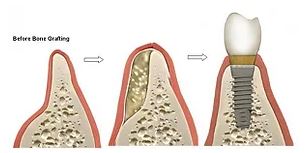If you’ve been thinking about getting dental implants to restore your smile, you might have already done some preliminary research online or perhaps have talked to people who have already had this treatment. Implants are small titanium alloy or ceramic posts surgically placed into the jawbone. One of the main questions asked by people considering dental implant treatment in Ajax is whether they will need a bone graft.
This can only be determined when you have a proper examination including diagnostic x-rays and a cone beam CT scan. In the meantime, we’ve put together a few of the most commonly asked questions about bone augmentation.
What Is a Bone Graft?
A bone graft or bone augmentation in Whitby is a small surgical procedure to restore bone which is lost due to trauma or disease or to build it up in areas where it is naturally thinner. The aim is to ensure the dental implants have plenty of strong, healthy bone to support them properly.
Why Has a Bone Graft Necessary?
Typically, bone is lost due to resorption that occurs after the first year of tooth loss. During this time, you can lose a considerable percentage of your bone density and this bone loss will continue, although at a slower rate. Bone loss occurs because your natural tooth roots provide essential stimulation to the jawbone, signalling the body that it must continue renewing old bone cells to keep your jawbone strong and healthy. When teeth are removed, stimulation is lost, resulting in bone resorption. Other times, bone density can be lost because of periodontal or gum disease in Bowmanville, if you have a severe tooth infection or other injuries.
When Would I Need a Bone Graft for Dental Implants?
Typically, dental implants must be surrounded by several millimetres of healthy bone that has the correct density to support a dental implant post. If the bone is too weak, it won’t provide the proper support for the implant post. To think of it another way, just imagine trying to insert a screw into a piece of wood that is too narrow to support it successfully! By building up the bone in your jaw, our implant dentist in Pickering will make sure there is plenty of bone to support the dental implants, significantly improving the chances of enjoying a successful, long-term restoration.
Where Does the Bone Come from?
Bone can be taken from another site in your body, or it can be processed bone from a different source. Often the bone material used is artificial and is designed to help regenerate your own bone, providing a kind of framework or scaffolding to encourage new bone growth.
What is the Bone Graft Procedure Like?
When only a minimal amount of bone is needed, it might be possible to place it when a tooth is removed or when the dental implant in Newcastle is inserted. Otherwise, it is a standalone procedure. Please don’t worry because here at Durham Dental Solutions, we use plenty of anesthetic or can provide additional sedation to ensure you feel entirely comfortable during the treatment.
The area requiring extra bone is precisely identified during treatment planning, so only a small incision is needed to expose the bone. The grafting material is carefully placed in position and is secured before the gum is stitched up. Next, the bone graft must be left to heal with your natural bone, a process that usually takes several months. Once completed, your dental implants can be placed.
Although a bone graft in Clarington may slow down treatment slightly, it is only a short delay and is well worth it given that dental implants can last for many years.


